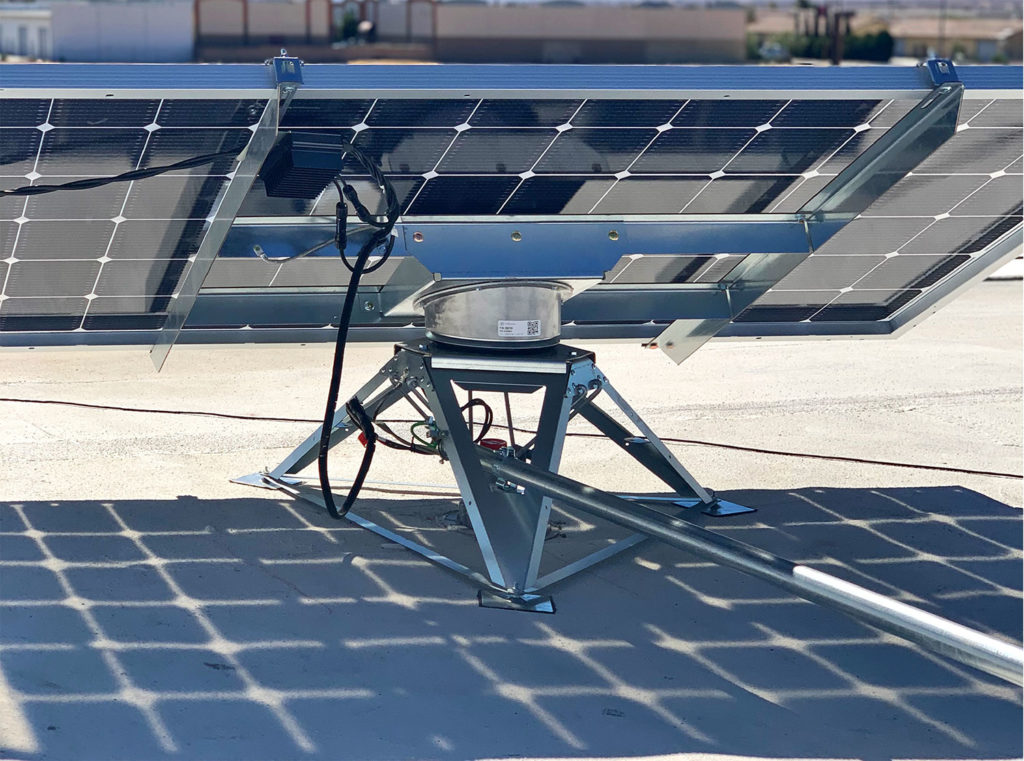
With just seven employees, Start Up of the Year Platinum award winner Point Load Power, the cleantech company leading the advancement of solar rooftop tracking for commercial and industrial (C&I) buildings, also received the Platinum award for their flagship technology, PV BoosterTM Gen 2. This next generation rooftop tracking system has been 3rd party tested, validated, and optimized for bifacial modules to deliver up to 70% more solar generation per panel compared ordinary to fixed-tilt racks.
These disruptive economic benefits have the power to catalyze and transform the industry on a massive scale. According to EIA.gov, the 120 million commercial buildings in the U.S. spend more than $290 billion on energy, and those costs continue to rise every year. Point Load sees the 87 billion square feet of vacant commercial rooftops as “idle real estate assets” waiting to be unlocked. The full-scale deployment of Point Load’s PV Booster rooftop solar tracking systems has the potential to generate trillions of dollars of economic growth with increased property values and new jobs. It could also reduce grid electricity demand by an estimated 45% and annual CO2 emissions by an estimated 675 million metric tons per year.
Ground-mounted tracker deployments have increased in popularity over the last decade, and are proven to deliver 30-35 percent more efficiency from solar projects. As a result, approximately 75 percent of all ground-mounted solar installations today use trackers. Unfortunately these powerful benefits have been limited to ground-mounted projects as there are unique challenges to deploying trackers on rooftops, such as weight and wind, which had never been solved.
However, there was acknowledgement that if the weight and wind problems could be solved, trackers could catalyze the market by making rooftop solar projects more economical, a critical driver that enabled the utility-scale solar market to grow more than 6,000% since 2005. Also, many C&I customers don’t have space on the ground as it’s usually reserved for real estate development and the roof was really the only place they could go.
Point Load was founded at Idealab, the pioneering incubator led by renewable energy visionary and founder Bill Gross, and the company’s team of former large-scale solar project developers determined to transform the industry and deliver on the “new economics of solar” for peer developers and integrators.
After four years of intensive research and development and hundreds of conversations with potential customers and industry experts, Point Load learned that while people quickly understood the benefits of rooftop tracking, there was still a huge knowledge gap in terms of what it takes to sell solar, storage or electrical services to building owners.
They saw this gap as an opportunity to create and market a product that building owners could use and clearly understand the benefits quickly to take action. Point Load’s first customer involved a project with HRI Real Estate Group and Chiquita Brands International which eventually led the building owner to see a 225 percent cash-on-cash return on their solar investment within 18 months.
How Does PV Booster Work?
PV Booster attaches to the roof using industry-accepted PV attachment methods that adhere to manufacturer warranty requirements, and is generally spaced 8 feet center-on-center to align with most flat rooftop structures. Key benefits of PV Booster system designs include less weight less per square foot, lower heat accumulation, better accessibility for service and maintenancce crews, and less intallation steps compared to fixed-tilt rooftop racking systems. The best part however, is that once a PV Booster system is installed and connected to the internet, each tracker is remotely uploaded with HelioPointTM, a proprietary tracking control and operations software that gets trackers tracking and solar panels generating more energy, all at the push of a button.
What Lies Ahead?
“Every trend that we’re seeing in solar supports C&I market take-off, says Co-Founder Conrad Chase. “It’s clearly the case in California as new rebates for storage go up and Time of Use (TOU) pricing drives favorable economics for solar use over traditional grid electricity.” Another trend for next year involves a big investment in making tracker-enhanced bifacial projects bankable. Point Power Load’s PV Booster is optimized for working with bifacial panels, so they stand to benefit once again.
